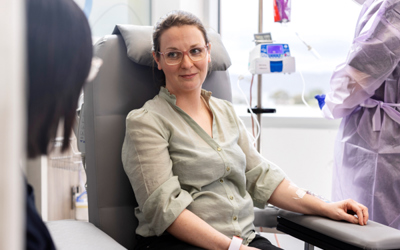What is hand foot syndrome?
Hand foot syndrome is a common side effect associated with a number of chemotherapy drugs affecting the skin and sensation on the palms and soles. The symptoms usually resolve within two weeks if the drug causing the effect is stopped.
What causes hand foot syndrome?
The exact cause of hand foot syndrome is unknown, but it tends to occur days to weeks after commencing treatment with certain chemotherapy drugs. It most commonly develops after six weeks of treatment.
What are the signs and symptoms of hand foot syndrome?
Hand foot syndrome is characterised by the gradual onset of reactions over the palms and soles including:
Skin redness
Tenderness
Pain
Swelling
Tingling
Numbness
Itching
Blistering lesions
Dry rash
Thinning and broken skin which weeps fluid
Ulceration
Sensory impairment

How can hand foot syndrome be prevented or managed?
Your care team will discuss if you are at risk of hand foot syndrome before starting treatment. Prior to starting treatment, you should avoid the use of soaps, use lukewarm water, avoid heat and sun exposure and liberally apply emollients on your skin.
The following may help you reduce the development and severity of hand foot syndrome as well as pain, discomfort and further infection:
Gently apply an emollient to hands and feet daily (e.g. an emollient containing urea 10%)
Bathe or shower in lukewarm water
Soak hands and feet in a basin of cold water for 15 minutes three to four times per day if possible
Avoid sun exposure and use a SPF 30+ sunscreen
Avoid activities that cause friction and rubbing of the skin surfaces or even slight pressure on hands, such as vigorous washing, clasping or clapping of hands, gripping tools or appliances, typing, playing musical instruments and driving
Avoid contact with chemicals such as detergents and cleaning products
Elevate hands and feet when sitting
Wear cotton gloves
Wear thick cotton socks especially if standing for long periods
Use a gel shoe insole cooled prior to placing in your shoe
Avoid tight-fitting shoes
Avoid any unnecessary walking, jogging or vigorous exercise
Avoid topical anaesthetic containing creams as they may exacerbate skin toxicity
Avoid exposure of hands and feet to heat
Report any skin changes to health professionals as soon as possible
Symptoms may be treated using topical wound care, cold compresses, moisturisers, topical corticosteroids and systemic analgesics. The most effective treatment for hand foot syndrome involves delaying planned treatment or reducing treatment dosages.
Severe cases may require stopping the chemotherapy drug which is causing hand foot syndrome and/or referral to a dermatologist.
Every patient is different, please discuss your own personal situation with your treating doctor of Icon care team.
Common side effects from chemotherapy
Hand foot syndrome
Anaemia Appetite and taste changes Bleeding and low platelets (thrombocytopenia) Constipation Diarrhoea Feeling emotional Flu-like symptoms Hair loss Infection Infertility Lymphoedema Mouth sores or ulcers Nausea and vomiting Peripheral neuropathy Sexual dysfunction Skin and nail changesReady to discuss your care?
We’re here to support you through your treatment. Get in touch with us for more information about our centre and the services we offer.




